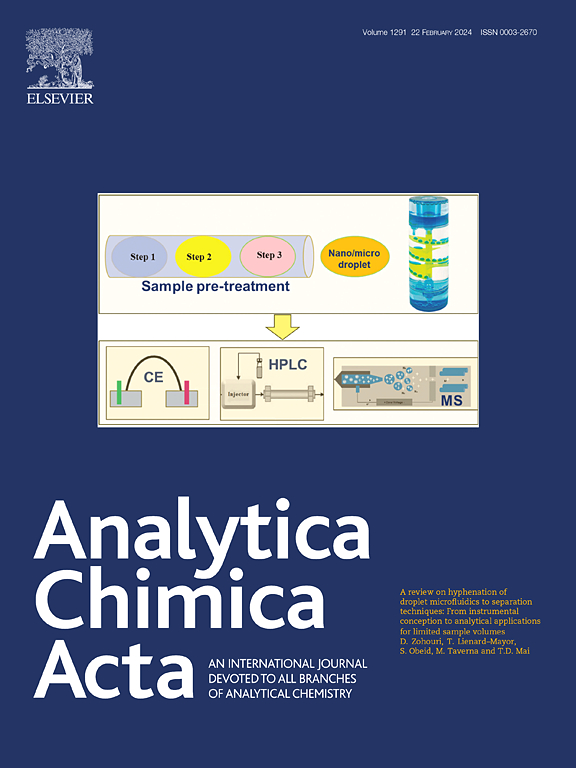Simple and sensitive monitoring of polycyclic aromatic hydrocarbons in edible oils by polydimethylsiloxane/pyrazine-based hyper-crosslinked polymer coated stir bar sorptive extraction followed by gas chromatography-mass spectrometry detection
IF 6
2区 化学
Q1 CHEMISTRY, ANALYTICAL
引用次数: 0
Abstract
Background
Edible oils are susceptible to contamination with polycyclic aromatic hydrocarbons (PAHs) throughout production, storage, and transportation processes due to their lipophilic nature. The necessity of quantifying PAHs present in complex oil matrices at trace levels, which bind strongly to impurities in oil matrices, poses a major challenge to the accurate quantification of these contaminants. Therefore, the development of straightforward and effective methods for the separation and enrichment of PAHs in oil samples prior to instrumental analysis is paramount to guaranteeing food safety.
Results
A pyrazine embedded hyper-crosslinked porous polymer, HCPPz-TPB, was synthesized via a Friedel-Crafts reaction, utilizing triphenylbenzene (TPB) as the monomer and 2,5-dibromomethylpyrazine as the cross-linking reagent. The material was combined with polydimethylsiloxane (PDMS) using the sol-gel method, and applied as a coating to a dumbbell-shaped stir bar prepared in-house. Using stir bar sorptive extraction (SBSE) combined with gas chromatography-mass spectrometry (GC-MS), 15 PAHs in edible oils were successfully quantified. Optimal conditions for the extraction of PAHs were experimentally investigated, with factors such as stirring rate, extraction time, extraction temperature, desorption solvent, and desorption time systematically optimized. The final method demonstrated a broad linear range (0.12–150 ng g−1), and low limits of detection (0.04–0.28 ng g−1). The recoveries of PAHs in real edible oil samples ranged from 83.14 % to 128.01 %, with relative standard deviations (RSDs) below 13.47 %.
Significance
This method simplifies PAH extraction by eliminating steps such as saponification, liquid-liquid extraction, drying, and re-dissolution, thus reducing potential analyte loss and errors associated with the inclusion of multiple pretreatment steps typical of conventional methods reported in the literature. Notably, the adsorbent materials prepared in this study can be reused up to 30 times, underscoring its sustainability. The proposed research broadens the diversity of coating choices for SBSE applications while offering a streamlined, cost-effective, and greener alternative for PAH determinations in edible oils via SBSE/GC-MS.


通过聚二甲基硅氧烷/吡嗪基超交联聚合物涂层搅拌棒吸附萃取,然后进行气相色谱-质谱检测,对食用油中的多环芳烃进行简单灵敏的监测
食用油由于其亲脂性,在生产、储存和运输过程中容易受到多环芳烃(PAHs)的污染。复杂油基质中存在痕量多环芳烃,它们与油基质中的杂质结合强烈,对这些污染物的准确定量提出了重大挑战。因此,在仪器分析之前,开发简单有效的分离和富集油样中多环芳烃的方法对保证食品安全至关重要。结果以三苯基苯(TPB)为单体,2,5-二溴甲基吡嗪为交联剂,采用Friedel-Crafts反应合成了吡嗪包埋的超交联多孔聚合物HCPPz-TPB。采用溶胶-凝胶法将该材料与聚二甲基硅氧烷(PDMS)结合,并将其作为涂层涂在自制的哑铃形搅拌棒上。采用搅拌棒吸附萃取(SBSE)结合气相色谱-质谱联用(GC-MS)技术,成功地定量了食用油中的15种多环芳烃。实验研究了提取多环芳烃的最佳条件,对搅拌速率、提取时间、提取温度、解吸溶剂、解吸时间等因素进行了系统优化。该方法具有较宽的线性范围(0.6 ~ 150 ng g-1)和较低的检出限(0.04 ~ 0.28 ng g-1)。实际食用油样品中多环芳烃的回收率为83.14% ~ 128.01%,相对标准偏差(rsd)在13.47%以下。该方法通过消除皂化、液-液萃取、干燥和再溶解等步骤,简化了多环芳烃的提取,从而减少了潜在的分析物损失和与文献中报道的传统方法中典型的多个预处理步骤相关的误差。值得注意的是,本研究制备的吸附材料可重复使用30次,突出了其可持续性。拟议的研究拓宽了SBSE应用的涂层选择的多样性,同时为通过SBSE/GC-MS测定食用油中的多环芳烃提供了一种精简、经济、环保的替代方案。
本文章由计算机程序翻译,如有差异,请以英文原文为准。
求助全文
约1分钟内获得全文
求助全文
来源期刊

Analytica Chimica Acta
化学-分析化学
CiteScore
10.40
自引率
6.50%
发文量
1081
审稿时长
38 days
期刊介绍:
Analytica Chimica Acta has an open access mirror journal Analytica Chimica Acta: X, sharing the same aims and scope, editorial team, submission system and rigorous peer review.
Analytica Chimica Acta provides a forum for the rapid publication of original research, and critical, comprehensive reviews dealing with all aspects of fundamental and applied modern analytical chemistry. The journal welcomes the submission of research papers which report studies concerning the development of new and significant analytical methodologies. In determining the suitability of submitted articles for publication, particular scrutiny will be placed on the degree of novelty and impact of the research and the extent to which it adds to the existing body of knowledge in analytical chemistry.
 求助内容:
求助内容: 应助结果提醒方式:
应助结果提醒方式:


